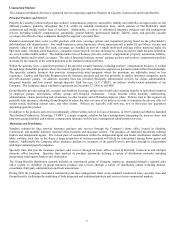The Hartford 2010 Annual Report Download - page 10
Download and view the complete annual report
Please find page 10 of the 2010 The Hartford annual report below. You can navigate through the pages in the report by either clicking on the pages listed below, or by using the keyword search tool below to find specific information within the annual report. 10
Reserves
The Hartford establishes and carries as liabilities reserves for its insurance products to estimate for the following:
• a liability for unpaid losses, including those that have been incurred but not yet reported, as well as estimates of all expenses
associated with processing and settling these claims;
• a liability equal to the balance that accrues to the benefit of the Wealth Management insurance policyholder as of the consolidated
financial statement date, otherwise known as the account value;
• a liability for future policy benefits, representing the present value of future benefits to be paid to or on behalf of policyholders less
the present value of future net premiums;
• fair value reserves for living benefits embedded derivative guarantees; and
• death and living benefit reserves which are computed based on a percentage of revenues less actual claim costs.
Further discussion of The Hartford’ s property and casualty insurance product reserves, including asbestos and environmental claims
reserves, may be found in Part II, Item 7, MD&A – Critical Accounting Estimates – Property and Casualty Insurance Product Reserves,
Net of Reinsurance. Additional discussion may be found in the Company’ s accounting policies for insurance product reserves within
Note 11 of the Notes to Consolidated Financial Statements.
Reinsurance
The Hartford cedes insurance risk to reinsurance companies for both its property and casualty and life insurance products. Ceded
reinsurance does not relieve The Hartford of its primary liability and, as such, failure of reinsurers to honor their obligations could result
in losses to The Hartford. For further discussion, see Note 6 of the Notes to Consolidated Financial Statements.
For property and casualty insurance products, reinsurance arrangements are intended to provide greater diversification of business and
limit The Hartford’ s maximum net loss arising from large risks or catastrophes. A major portion of The Hartford’ s property and
casualty insurance product reinsurance is effected under general reinsurance contracts known as treaties, or, in some instances, is
negotiated on an individual risk basis, known as facultative reinsurance. The Hartford also has in-force excess of loss contracts with
reinsurers that protect it against a specified part or all of a layer of losses over stipulated amounts. For further discussion on property
and casualty insurance product reinsurance, see Part II, Item 7, MD&A – Insurance Risk – Reinsurance.
For life insurance products, The Hartford is involved in both the cession and assumption of insurance with other insurance and
reinsurance companies. As of December 31, 2010 and 2009, the Company's policy for the largest amount of life insurance retained on
any one life by any one of its operations was $10. The Company also assumes reinsurance from other insurers. For the years ended
December 31, 2010, 2009 and 2008, the Company did not make any significant changes in the terms under which reinsurance is ceded
to other insurers. In addition, the Company has reinsured a portion of the risk associated with U.S. minimum death benefit guarantees,
Japan’ s guaranteed minimum death, as well as U.S. guaranteed minimum withdrawal benefits offered in connection with its variable
annuity contracts. For further discussion on reinsurance, see Part II, Item 7, MD&A – Market Risk – Variable Product Equity Risk.
Investment Operations
The majority of the Company’ s investment portfolios are managed by Hartford Investment Management Company (“HIMCO”).
HIMCO manages the portfolios to maximize economic value, while attempting to generate the income necessary to support the
Company’ s various product obligations, within internally established objectives, guidelines and risk tolerances. The portfolio objectives
and guidelines are developed based upon the asset/liability profile, including duration, convexity and other characteristics within
specified risk tolerances. The risk tolerances considered include, for example, asset and credit issuer allocation limits, maximum
portfolio below investment grade holdings and foreign currency exposure. The Company attempts to minimize adverse impacts to the
portfolio and the Company’ s results of operations from changes in economic conditions through asset allocation limits, asset/liability
duration matching and through the use of derivatives. For further discussion of HIMCO’ s portfolio management approach, see the
Investment Credit Risk Section of the MD&A.
In addition to managing the general account assets of the Company, HIMCO is also a SEC registered investment adviser for third party
institutional clients, a sub-advisor for certain mutual funds and serves as the sponsor and collateral manager for capital markets
transactions. HIMCO specializes in investment management that incorporates proprietary research and active management within a
disciplined risk framework that seeks to provide value added returns versus peers and benchmarks. As of December 31, 2010 and 2009,
the fair value of HIMCO’ s total assets under management was approximately $159.7 billion and $144.0 billion, respectively, of which
$8.7 billion and $8.1 billion, respectively, were held in HIMCO managed third party accounts.























